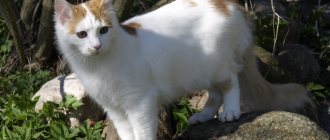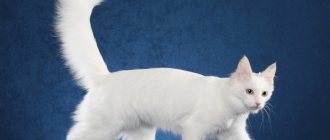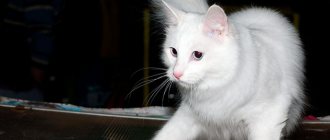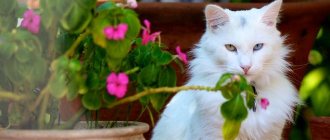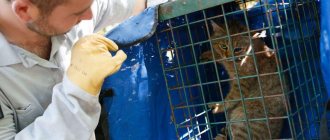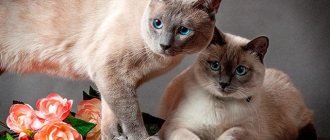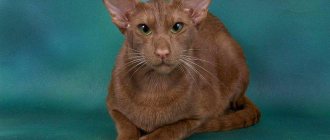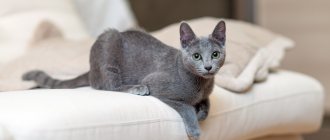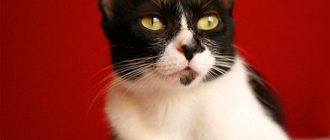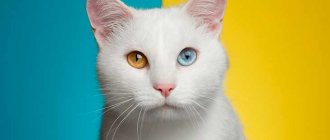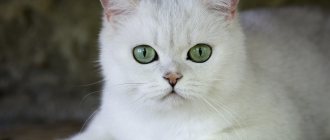The Turkish Angora has won the love of millions of cat lovers around the world. Amazingly soft skin, multi-colored eyes of unearthly beauty, a sense of one’s own greatness in the gaze, coupled with a dog’s loyalty. These are the reviews you can hear about this breed.
In order for an Angora cat to take root in the house and delight its owners with its presence for many years, you need to know everything about the breed: character, care features, congenital defects, as well as breeding features.
Brief history of the breed
Turkish Angoras are cats with a rich past, which is surrounded by many mysteries and legends. They lived next to people for several centuries and belonged mainly to noble persons. Their homeland is Turkey, and among their ancestors are Caucasian forest cats (they lived on these lands in the Middle Ages).
They came to Europe at the dawn of the 17th century thanks to an Italian aristocratic traveler. During his next trip, he noticed unusual animals with long snow-white hair and decided to take them with him.
Turkish Angoras quickly gained popularity among representatives of the European aristocracy. These animals were the favorites of the all-powerful Cardinal Richelieu, Marie Antoinette, Théophile Gautier, Victor Hugo and the Russian Empress Catherine the Great.
In the first half of the 19th century, cats were brought to America, but local breeders began to use them to breed Persians. As a result of the lack of systematic selection, the population of the Angora breed declined sharply, and in the 1950s, European felinologists began to work closely on its restoration.
Cats received official recognition from the CFA only in 1973. Initially, the standard specified only white coat color. But in 1978, enthusiasts managed to achieve recognition of the colored angora. Currently, the breed has official status in all world felinological associations.
History of the origin of Turkish Angoras
global $ads_google;
//data-ad-slot=”2475549904″ $ads_google = empty($ads_google) ? false : true; ?> if ($ads_google == false) {?> $ads_google = true; ?> } ?> The history of the origin of the Turkish Angora is the most natural. There are legends about the breed: one of them says that the Prophet Muhammad had eyes of different colors, and since this phenomenon also often occurs in these beautiful creatures, cats are sacred.
The second legend is associated with the name of the national hero of Turkey Mustafa Kemal Ataturk. Ataturk also had eyes of different colors, and he said that whoever was bitten by the odd-eyed angora would follow in his footsteps. It becomes clear the respect that surrounds a cat in its actual homeland.
Although if you delve into the history of the breed, then most likely the cat arrived in Asia from Africa, probably from Egypt. Europe saw creatures with long white hair and different eyes during the Crusades.
The popularity of cats of this breed made them universal favorites outside of Turkey, in Europe, Russia and then in the USA. They began to be used in breeding the Maine Coon and Persian breeds, but Angora cats became the property of the country.
This breed has European and American varieties and hence a large variety of different colors.
Breed description, standards, appearance
The Angora cat is a graceful animal with a long flexible body and lightweight bones. Her trademark is her elegant movements and beautiful soft coat. A detailed description of the breed is presented in a generally recognized standard.
Dimensions and weight
Turkish Angoras are medium-sized animals with moderate sexual dimorphism. The weight of a cat of this breed is 2.5-4 kg. Cats weigh between 3-5 kg.
Anatomical characteristics
A typical Angora cat should fit the following description:
- The head is small, wedge-shaped, with a flat skull, elongated muzzle, rounded chin and slightly convex cheeks. The nose is straight, the whisker pads are not visible.
- The eyes are large, widely set, rounded, slightly slanted. The iris is colored yellow, green or blue. According to the standard, heterochromia is allowed in Turkish Angora cats.
- The ears are large, vertically set, with a wide base and dense feathering inside.
- The body is slender and toned. The croup is located just above the shoulders. The neck is graceful, of medium length.
- The limbs are tall and slender. The front legs are slightly shorter than the hind legs. Tufts of wool are welcome in the interdigital space.
- The tail is long, well furred, tapering smoothly from base to tip.
Color and coat type
Angora is a long-haired cat. Its body is covered with silky crumbly hair, under which there is practically no down. The Angora cat has very developed decorative hair. It has a luxurious “collar” on the neck, “breeches” on the hind legs and a dewlap on the tail.
Although the most popular is the white angora, the standard allows for the existence of other colors. Representatives of the breed can have the following colors:
- Black. The cat's fur is colored in a uniform charcoal shade. The black angora has dark brown or anthracite paw pads.
- Red. The fur of the Angora cat is colored a rich brown-red color without spots or light areas. The nose and paw pads are brick.
- Blue. Solid gray color with a light tint. The paw pads and nose are blue.
- Cream. Angora wool is colored in a delicate peach shade. The nose and paw pads are pink.
- Black smoke. The charcoal awning of the Angora is combined with a white undercoat. The smoky effect is especially noticeable when the cat moves. The paw pads are colored blue.
- Tabby. Patterned color with marbled or brindle pattern.
- Bicolor. A combination of any shade with white.
Description and colors
Purebred Angora cats come in not only white, but also in a variety of colors.
- White is the most popular color with a pink nose and pink paw pads.
- Black color. The paw pads and nose are brown or black.
- Cream shade combined with white stripes.
- Blue is a delicate silvery coat color. The nose and paws are the same color.
- Two-color angoras are one third white, and the rest of the wool is a different color.
- Red cats - without adding another shade. Dense, rich color, red nose and paws.
- Tortoiseshell is the original color of the Angora - a mixture of black, red and cream shades.
- Calico is a spotted Turkish Angora, red and black. Most of the fur is white.
According to breed standards, cats cannot be chocolate, lilac or Himalayan in color. This is considered a cull.
Character and temperament
Turkish Angoras are discreet cats with regal demeanors. They are very curious, sensitive and persistent. Angora cats subtly sense not only the mood of their owners, but also their attitude towards themselves. Representatives of the breed do not like loneliness and do not tolerate long-term separation from their owner.
On a note. Angora cats prefer to communicate with people through uterine purring sounds. They are not the type to attract attention by meowing loudly.
The patient nature of the Turkish Angora allows it to easily connect with children. A cat of this breed is lenient towards childish pranks and, if in a good mood, will gladly take part in games.
The Turkish Angora gets along well with its relatives and friendly dogs, especially if it grew up with them. In other cases, she may conflict with other pets, vying for the owner's attention. This cat has developed hunting instincts, so it should not be kept together with ornamental birds, rodents and aquarium fish.
Health and Diseases of the Turkish Angora
The Turkish Angora has good health, allowing the pet to live up to 15-20 years with proper care. Adults may suffer from congenital diseases and tartar. Kittens are susceptible to ataxia and other ailments, so constant monitoring by a veterinarian is important for up to six months. Old cats sometimes suffer from cardiomyopathy and suffer from neoplastic tumors.
White individuals with blue eyes are often born deaf, although this does not change their character. It is better to completely transfer such animals to home care and walk them on a harness. In bicolor cats, deafness may affect only one ear (the side of the blue eye).
How to choose the right kitten
The Turkish Angora is as common as the Persian or Siberian cat. Therefore, as a rule, there are no special problems with finding a kitten of this breed. To be sure that your future pet is purebred, before purchasing, you should make sure that it has documents of origin and a veterinary passport with vaccination marks.
A healthy Angora kitten should stand confidently on its feet, have an excellent appetite and exhibit natural curiosity. It is important that he does not have kinks in the tail, a bloated belly, excessive discharge from the eyes, an unpleasant odor from the mouth, dirt in the ears and scratches on the skin.
Kitten care
In good nurseries, Turkish Angora kittens are sent to new homes no earlier than three months of age. By this point, they are already fully vaccinated and do not need maternal care. Conscientious breeders accustom Angora kittens to the litter tray and scratching post in advance. Therefore, new owners can only show the pet where its bowls, toilet and sleeping bed are located.
In order for the Angora kitten to quickly adapt to the changed environment, it is petted, praised and involved in active games more often. And in order to protect the baby from household injuries, wires, indoor plants, chemicals and fragile objects are removed from him.
Health
Angora cats have excellent health and longevity, but in some cases deafness (in white, blue-eyed cats) and heart disease occur.
Angora is susceptible to a disease called ataxia. Cerebellar ataxia in cats is a neurological disease that is characterized by impaired coordination of movements. This disease occurs due to damage to the cerebellum during the intrauterine development of kittens. Usually the disease manifests itself as soon as the kittens begin to actively move. Animals affected by this disease do not experience pain, their mental abilities and life expectancy do not differ from healthy animals.
Symptoms: with this disease, animals move with difficulty, shake their heads, stagger when walking, and also spread their paws wide. Cerebellar ataxia has three forms: mild (the cat moves normally, but rarely falls), moderate (the cat can walk, but often falls), and severe (the cat cannot move independently at all). Qualified veterinarians can diagnose this disease by visual examination, but the exact diagnosis is only known by MRI results, since similar symptoms can be observed with degenerative changes, as well as with brain tumors.
There is no cure for cerebellar ataxia, but the disease does not progress over time. This diagnosis is not a death sentence, since statistics show that with an active lifestyle and constant muscle training, the pet’s condition improves significantly. Until recently, such kittens were euthanized, but today a large number of sick animals find homes. Such animals are especially affectionate and friendly. Despite their illness, becoming attached to a person and receiving love and care, they lead a full cat life.
Care and maintenance
Angora cats are native to a country with a hot climate. They do not have a thick undercoat and do not tolerate low temperatures well. Therefore, it is better to keep Turkish Angoras in warm rooms where there are no drafts or dampness. Otherwise, caring for cats of this breed comes down to basic hygiene and proper nutrition.
Hygiene procedures
In order for the Turkish Angora to look neat, it is provided with appropriate care:
- The cat's eyes and ears are checked daily for any unusual discharge and gently wiped with a moistened cotton swab.
- Angora teeth are cleaned 2-3 times a month with non-foaming paste, a silicone brush or a special attachment.
- As the cat's claws grow, they are very carefully shortened with a nail clipper so as not to injure living tissue.
Grooming
Since the Turkish Angora is not a short-haired cat, it requires regular grooming to maintain the beauty of its luxurious coat. The silky spine of the animal is combed 2-3 times a week with a special brush. During the molting period, the procedure is carried out more often in order to quickly get rid of dead hairs and promote the growth of new hair.
Turkish Angoras are not bathed often. Cats of this breed are given bath treatments 3-4 times a year. To prevent white wool from turning yellow, special shampoos are used during washing.
Tray
It is advisable to use a spacious tray with high sides as a toilet for the Turkish Angora. The filler can be anything.
On a note. Angora cats are clean animals. They will not go into a dirty tray, so it is necessary to clean it in a timely manner.
Feeding the cat
In order for the Angora cat to develop properly and remain active longer, a balanced diet is necessary. You can choose high-quality industrial food for her or create a natural menu.
Complete diet
When feeding dry Angora cats, they buy premium or super-premium products, which contain all the necessary microelements. The following brands are best suited for representatives of the breed:
- Bosch;
- Acana;
- Hills;
- Brit Care.
With a natural type of feeding, the Turkish Angora's diet should contain at least 70-80% meat. Also, a cat of this breed is given:
- lean sea fish;
- offal;
- porridge with water;
- boiled vegetables;
- eggs;
- sour milk.
Important. It is not advisable to feed the white Turkish Angora seaweed, liver and heart. These products contribute to yellowing of the coat.
Pork, sweets, potatoes, onions, baked goods and any leftovers from the host’s plate are completely excluded from the Turkish Angora’s diet.
Feeding frequency
Turkish Angora kittens eat less, but more often than adults. Therefore, the feeding schedule is made taking into account the age of the animal:
- 3-6 months – 5 times a day;
- 7-9 months – 4 times a day;
- 10-11 months – 3 times a day.
From the age of one year, the Angora cat is transferred to two feedings a day.
Vitamins and minerals
When fed dry food, an Angora cat does not need additional supplements. If a representative of the breed eats natural food, he is given vitamin and mineral complexes twice a year. They are selected on the advice of a veterinarian, taking into account the individual characteristics of the cat’s body.
Nutrition
Proper nutrition is the key to health, longevity and beautiful appearance of the Angora cat. Felinologists do not give clear recommendations regarding which food is preferable. Here you need to focus on the cat’s preferences and your own capabilities.
You can feed your pet either prepared food or keep it on a natural diet. In the first case, there are no problems, except that a purebred pet needs high-quality food, which is quite expensive.
However, industrial dry and wet food takes into account all the needs of the cat’s body, depending on its age, size, coat length and individual characteristics. High-quality food also contains beneficial vitamins and minerals necessary to maintain health.
It should be taken into account that the active and playful Turkish Angora needs adequate nutrition. The animal should be fed quite often, as it must replenish its energy reserves.
If you decide to feed your cat natural products, then you should prepare the diet correctly. The cat, although small, is a predator, and its nutrition should be based on protein foods, the share of which in the diet is at least 80%. You need to cook for your cat separately, without using salt, spices and other flavoring additives; food from a common table is not suitable for it, moreover, it can cause serious problems with the digestive tract.
The cat's diet should consist of the following products:
- lean varieties of meat, boiled or raw, but scalded with boiling water (it is necessary to grind the meat so that it is convenient for the animal to eat it);
- meat by-products;
- eggs, chicken or quail, can be included in the diet twice a week;
- dairy products: cottage cheese, yogurt (you don’t need to give whole milk to a cat, its gastrointestinal tract is not designed to digest it);
- The plant part of the diet should consist of boiled vegetables and greens (there is no need to feed your pet nightshades or very starchy vegetables).
To maintain health, your cat needs vitamins. To do this, she can be given tableted nutritional supplements. As a rule, they contain substances that attract the cat with smell and taste, so there are no problems giving the animal a tablet: they are simply placed with food.
A good food supplement is fish oil (only intended for cats), seaweed powder, as well as grass (sold in specialized stores directly in pots). The cat’s digestive tract has difficulty digesting flour, grains, and coarse fibers, so there is no need to feed such foods.
Education and physical activity
Turkish Angoras are smart and highly intelligent cats. They easily get accustomed to the tray and scratching post, and also quickly learn the rules established in the house.
On a note. Angora cats cannot be offended, otherwise they can take revenge and deliberately violate established orders.
Representatives of the breed are very active and temperamental. Turkish Angoras easily open doors, bags and cabinets. They enjoy running after balls and laser pointers.
To maintain physical fitness and realize hunting instincts, Angora cats are given interactive toys and a corner with multi-level shelves and ladders is set up.
Needs
Turkish Angoras get along well with children if they have time to get used to them. However, it is important to ensure that a very young child does not painfully grab the cat’s fur or pull its tail. They will not tolerate such treatment, unlike, for example, Himalayan cats.
Angoras can be friendly towards other cats or dogs if introduced correctly. However, these cats do well without companions and usually do not experience stress if left alone.
Like all cats, Turkish Angoras need a variety of toys and several scratching posts for a happy, active life (and to keep your furniture snag-free). They also like to climb higher, and it’s good if you have points in the house from which they can observe their possessions.
A tall cat tree, hanging shelves or a hammock can become your pet's favorite place. If there is nothing like that, most likely the cat will climb onto the cabinet or door.
Vaccinations and antiparasitic treatment
To prevent viral and infectious diseases, Turkish Angoras are regularly vaccinated with a complex drug that activates the production of immunity to calcivirosis, rhinotracheitis and panleukopenia.
The kitten is first vaccinated at the age of 7-8 weeks. After 4 weeks he is vaccinated against the same diseases and against rabies. Subsequently, the Angora cat is vaccinated once a year.
To prevent diseases transmitted by fleas and worms, representatives of the breed are systematically subjected to antiparasitic treatments. To combat helminths, specialized drugs are used, the dosage of which depends on the weight of the Angora cat. They are given twice a year with mandatory repetition after 10-14 days.
Turkish Angoras are treated against fleas with special drops or shampoos. And if the cat is outdoors, it is additionally protected with an anti-parasitic collar.
Characteristic diseases
The Angora is hardy, active and famous for its good health, but cat ailments such as:
- Oral diseases. It is necessary to regularly examine your teeth, brush them and remove tartar.
- Ataxia. It can be detected at the age of one month, so the risk of purchasing a kitten with such a problem is minimal.
- Congenital deafness. Those who breed Angora dogs at a certain stage conduct special tests to determine carriers of the bad gene.
- Diseases of the cardiovascular system. You should bring your cat to the veterinarian for examinations in a timely manner to detect the disease at an early stage.
Pros and cons of the breed
Like representatives of any other breed, Angora cats have not only positive, but also negative traits.
| pros | Minuses |
| Pretty appearance | Heavy shedding |
| High intelligence | Increased activity |
| Cleanliness |
The Turkish Angora is an amazingly beautiful cat with regal manners and luxurious fur. She will be an excellent companion for those who are willing to spend enough time with her and put up with heavy shedding.
Conclusions about the breed
Known beyond its hometown of Ankara Zoo, the Turkish Angora is renowned throughout the world for its virtues:
- calm and affectionate character, ability to get along with small households and lack of desire to spoil interior items;
- cats have good health and a high level of immunity;
- The amazing grace, elegance and beauty of the fur do not require much care and heavy maintenance.
On the Internet, lovers share various videos about the antics of their Angoras, and it becomes clear what causes such love on the part of people.
global $ads_google; //data-ad-slot=”2475549904″ $ads_google = empty($ads_google) ? false : true; ?> if ($ads_google == false) {?> $ads_google = true; ?> } ?>
